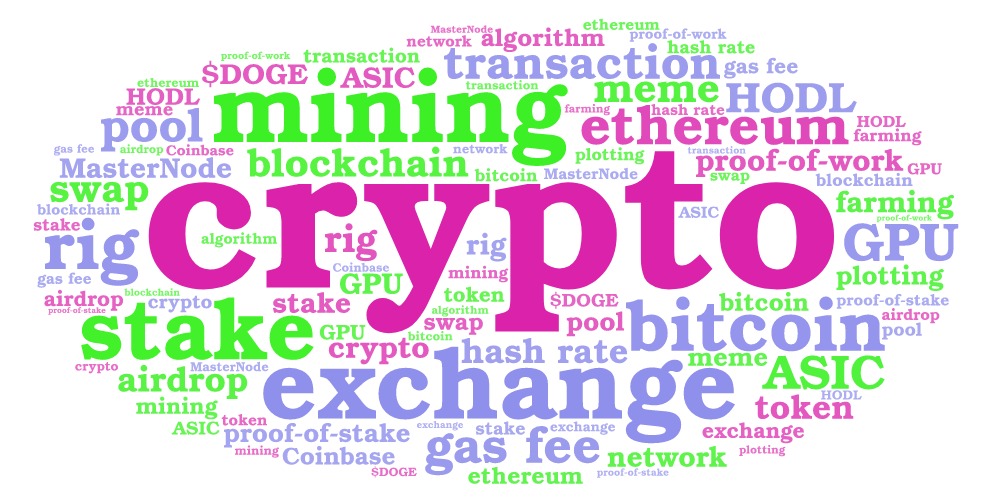
When speaking with others about cryptocurrency, sometimes it is hard for them to get interested in it. At first I thought this was purely because it was a niche-geek techie activity, but that’s only part of it. It recently dawned on me that not understanding the vocabulary is probably a big contributor. How do you engage or even get interested in something if you don’t understand the underlying terms and how they are related? The people I had been talking to about crypto were smart people, just unfamiliar with some of the vernacular. Discussions like that leave people feeling inadequate or dumb, and I hate that it does that to them. To remedy that, I have started my own glossary that may help people bridge the gap in discussions about cryptocurrency. I have found some of the definitions out in the public lacking, so I am using my own wording that I feel will be more easily digested by the general public (unless otherwise noted, in quotes/sourced).
Feel free to comment below if you have heard any terminology that has confused you, and I can add that to the glossary as well to save others the hassle.
Basics
Cryptocurrency (AKA “crypto”): a form of digital currency that can be used as legal tender on the open market. The longer version: “a digital currency in which transactions are verified and records maintained by a decentralized system using cryptography, rather than by a centralized authority.” (source: Google Dictionary)
Coin: a type of cryptocurrency that can be acted on by an exchange, group or individual: bought/sold, staked, traded or held as well as acquired through mining or farming/harvesting.
Token: a type of cryptocurrency that can be acted on by an exchange, group or individual: bought/sold, staked, traded, or help, but cannot be acquired through mining or farming.
Meme Coin: a cryptocurrency that originated from a popular Internet meme (e.g. $DOGE)
NFT (Non-Fungible Token): a digital asset that can be sold or traded on specific websites or other online venues. Typically these are auctioned and the assets consist of famous memes, artistic works, or some other culturally significant or popular digital creation. The same of an NFT is recorded in the blockchain, and typically act as collectibles. These collectible are trophies or sorts, that come with bragging rights for the owner, but they cannot be used as legal tender like coins or tokens.
Bitcoin ($BTC): The first cryptocurrency coin in existence, invented by Satoshi Nakamoto. This coin is a PoW format coin, and is based on the SHA256 algorithm.
Ethereum ($ETH): A newer type of technology, and currently the most popular cryptocurrency to challenge Bitcoin. Ethereum, and other ERC20 based crypto, have many uses beyond just being a payment method. This give ETH-based coins (ERC20) an advantage over Bitcoin when it comes to usefulness, necessity and longevity in the market.
DOGE Coin ($DOGE): This is the first most popular cryptocurrency based on the Doge Meme from 2013.
Technologies:
PoS Proof of Stake (PoS): a format of coin that can be invested and generate interest by being locked into a savings account (i.e. staked) for profits. (e.g. Ethereum 2.0)
PoW Proof of Work (PoW): a format of coin that can be acquired through the process of mining using specialized hardware, depending on that coin’s algorithm. (e.g. Bitcoin)
Proof of Space and Time (PoST): a type of coin that requires both validation of storage space and the passage of time in order to be validated on the blockchain, and rewarded to the owner. Unlike traditional cryptocurrencies that are PoW (Bitcoin and Ethereum for example) this type of coin is much more environmental friendly as it does not require specialized hardware using large amounts of electricity to be acquired (see my post Ch-Ch-Ch-Chia! for an example of this)
Self-Generating Liquidity Token: This is similar to a Proof of Stake coin; however since it is a Token it cannot be mined. Also different from PoS, it does not need to be staked (i.e. locked up) in order to generate interest. Simply holding the token in a wallet will self-generate (reward) the holder with more of that type of token. The self-generation is rewarded at a ratio equivalent to the quantity held. (e.g. The more you hold the more you generate/get rewarded)
Mining / Hardware:
Mining: a term specific only to PoW coins. This is the process of using specialized hardware to solve mathematical equations for the purpose of gaining a reward. This involves finding “steps” toward a “block”; once a block is found, the reward is distributed to all PoW miners who contributed steps, and a pool owner if one is being used. The miner has the choice of solo-mining or mining in a pool.
Solo Mining: the process of a single individual mining by themselves, not in a pool, for the purpose of finding blocks and reaping greater rewards. Solo-mining for many coins is difficult, unless the coin is a new one that has not reached a specific mining difficulty rating yet.
Pool: a group of miners that work together to find blocks for a specific PoW coin, or set of coins/algorithms. This allows for faster progress toward finding rewards as opposed to solo-mining on your own.
Plotting: a term specific only to PoST coins. This is the process of creating a specific area within storage space that can later be farmed for rewards.
Farming: The process of scanning plots to find a winning record, that can then be “harvested”. These harvests unfinished blocks are then validate on the blockchain, for the purpose of distributing the reward.
Algorithm: The underlying procedure/structure used for solving a mathematical problem. This only applies to coins that have a PoW format, meaning they can be mined or farmed.
Rig: the term given by a cryptocurrency enthusiast for the specialized hardware they use to acquire cryptocurrency, typically through mining. (e.g. “My Ethereum mining rig has 8 GPU video cards with a hash rate of 350MH/s.”)
Hash Rate: The amount of available processing power that a set of mining hardware, or someone’s mining rig(s), can generate. This is measured in MH/s (mega-hashes per second) or KH/s, GH/s, TH/s. Ph/s, etc. The hash rate will vary across different algorithms for the same hardware.
CPU: The Central Processing Unit of a computer, used to mine certain PoW coin algorithms.
GPU: The Graphics Processing Unit (i.e. video card), used to mine certain PoW coin algorithms.
ASIC (Application-Specific Integrated Circuit): Specialized hardware used to mine certain PoW coin algorithms.
FPGA (Field-Programmable Gate Array): Specialized hardware used to mine certain PoW coin algorithms. (More here: FPGA vs GPU vs ASIC)
ARM/ARM64: Arm-architecture is the basis for many mobile devices, such as Android Smartphones and Tablets, which can also be used to do CPU mining of various PoW coins. The advantage here is that these devices still have powerful multi-core CPUs, but use considerably less power keeping the profitability ratio more favorable.
Network:
Blockchain: “a system of recording information in a way that makes it difficult or impossible to change, hack, or cheat the system. A blockchain is essentially a digital ledger of transactions that is duplicated and distributed across the entire network of computer systems on the blockchain” (source: EuroMoney.com)
Transaction: a single record within the blockchain (e.g. crypto that has been sent or received) that is verifiable by multiple decentralized nodes/sources. Once a transaction has been verified enough (e.g. 2-30 times) then the result of that transaction will be executed (e.g. User sends 0.05 BTC from Address A to Address B, the network will deduct a contextual fee, and then transfer the remainder to the destination, Address B. After the network has verified the transaction 10 times, the funds are then visible in the wallet for Address B)
Fee: the amount deducted from every transaction that takes place on the blockchain, for distribution to miners, master nodes and validators. When sending or receiving cryptocurrency, there is a percentage deducted in order to make that transaction possible. Transaction fees vary greatly depending on the coin or token being transferred. For example, $XLM has very low fees when transferred between addresses (sometimes it amounts to pennies for large amounts), as well as USDT when using the TRC20 network ($1 flat rate, regardless of the amount), while other cryptos have higher fees (e.g. Ethereum).
Gas Fee: The fee charged by the network when converting, swapping or sending ETH-based (Ethereum) tokens. Typically users will encounter these on Exchange DApps like Uniswap and PancakeSwap when using Ethereum to purchase other types of tokens. Gas fees can fluctuate based on the time of day, and sometimes even cost more than the actual cryptocurrency being purchased, making for very expensive exchanges.
Blocks: Increments in the blockchain consisting of steps. For PoW coins, these blocks require a specific mathematical calculation to unlock and reap their reward (shared among miners and MasterNodes). For PoS coins that cannot be mined, or for tokens, these are transactional blocks that make up the “chain”.
Steps: Increments in the blockchain that make up a block. For PoS coins, these are smaller solutions, or potential solutions, found along the way toward the goal of solving a block.
Nodes: these are connected computers/servers on the network that act as the decentralized backbone for communication and connectivity of a given blockchain.
Master Node: these are specific nodes that have been configured to verify transactions occurring on the blockchain. For each transaction, or set time period in some cases (@4 hours) the master nodes are rewarded with a part of the transactional fees (split up among all of them) as payment for being a validator on the network.
Tools & Practices
Wallet: an application with a private key, capable of storing cryptocurrency online or offline. Also capable of generating Send and Receive addresses for the purpose of exchanging cryptocurrency between wallets. All coins (PoW, PoS, PoST, etc) are stored in wallets. The private key is unique to that wallet, and for some specific coins, each address will have its own private sub-key underneath the wallet’s main key.
Trust Wallet & Metamask: Digital wallets that can be used from most iPhones, Androids and personal computers (Desktop/Laptop devices). These wallets and directly interact/integrate with DApps that provide the ability to act on coins (buy, sell, trade, stake, etc)
Address: generated by the wallet, this is the unique identifier for the Sender or Receiver when cryptocurrency is being transferred.
Memo: a secondary ID, sometimes required by a receiver (in addition to the unique address), in order for the cryptocurrency to reach its destination. Very few cryptocurrencies require a Memo, and most do not have a memo feature as part of their blockchain.
Staking: The process of storing cryptocurrency, typically ‘locking it in’ to a specific timebound account. Some places allow you to stake on-demand, and do not require a predetermined timebox.
HODL/HODLING (Hold/Holding): The term used to describe the act of keeping a cryptocurrency for an extended period of time. Originally someone misspelled the word “hold”, so now you will see many people use the term “HODL” when talking about saving their cryptocurrency and not selling it. The hopes here are that it will rise in value in the future. Many people who sell their cryptocurrency regret it since most everything rises/goes up over time in the crypto world (unlike the stock market)
Swap: converting one cryptocurrency to another (usually using an Exchange, but this can also be done privately between individuals).
Dollar-Cost-Averaging: The investment strategy of buying a set amount of assets (in this case, cryptocurrency) on a regular cadence (e.g. $100 every 2 weeks). Due to the volatility of the crypto market, it is easier to setup a recurring payment for this, than trying to time the market to buy low/sell high. This continual stream of investment helps minimize the risk of loss, but also still allows for decent gains when holding over a longer time period.
Exchanges
Exchange: A web or mobile app that allows live trading of various cryptocurrencies (coins and tokens) in real-time, as well as Deposit and Withdraw functions to move digital assets to/from external wallets.
CoinBase: currently the most popular cryptocurrency exchange, where users can buy/withdraw crypto directly with a bank account or debit card, as well as transfer assets to/from other external wallets. Users can use the CoinBase website on any popular browser, or a mobile application for their iOS or Android devices.
Uniswap / PancakeSwap: DApps that integrate to a digital wallet, providing the user with the ability to buy, sell and swap cryptocurrency. These are technically a special type of “exchange”.
DApps: Digital apps that can be linked directly to a digital wallet (e.g. Trust Wallet and MetaMask) in order to act on various digital cryptocurrencies and assets (e.g. Exchanging Coins, Buying Tokens or Bidding on NFTs)
Community/Collaboration:
Airdrop: The process of sending out free cryptocurrency reward to participants who sign up, complete some marketing challenge, or have current holdings. Typically these require a sign-up and take place within an exchange or other organized community group (e.g. Telegram chat)
Discord: this is a chat tool, originally used by the gaming community. Since the flourish of crypto, many people have started their own chat servers to discuss specific cryptocurrencies, exchanges, pools, hardware, and other related topics.
Telegram: this is a feature-rich text and chat tool that many coin and token creators use to reach their specific communities. Many cryptocurrencies have their own Telegram chat room where those who are interested in that specific crypto. Some of the activities include free airdrops/hand outs, chat and speculate, share tips or inside info, memes, exchange crypto privately off exchange, or discuss the next big thing coming. Users should be very careful, as there are many fake Telegram groups for some popular cryptocurrencies, with people attempting to gain access to unsuspecting users’ crypto wallets.
Reminder: Comment below letting me know about any other terms I may have missed, and I will update this post to make it more beneficial for others.

